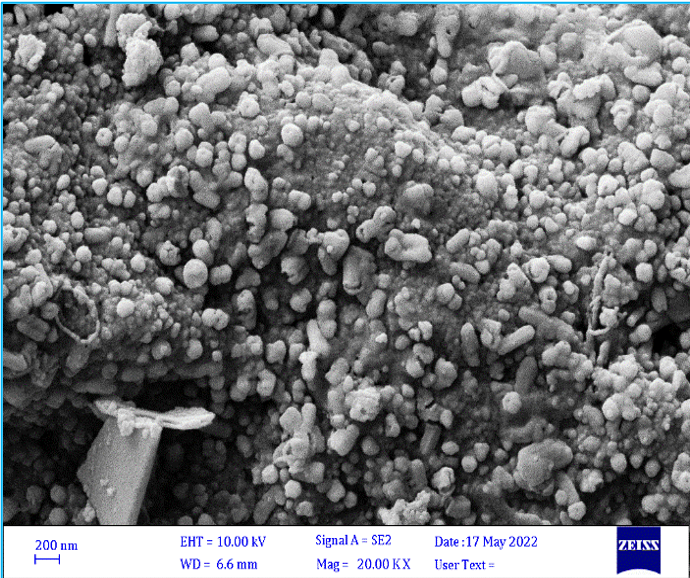Green Synthesis of Nickel Nanoparticles Using Lawsonia inermis Extract and Evaluation of Their Effectiveness against Staphylococcus aureus
DOI:
https://doi.org/10.23851/mjs.v36i1.1635Keywords:
Green synthesis, Nickle nanoparticles, Hyderothermal, Antibacteria, HennaAbstract
Background: Nanoparticle synthesis uses the green synthesis of nickel nanoparticles (Ni-NPs) because of its low cost, safety, environmental friendliness, simplicity, and ability to treat environmental pollution. Objective: The goal of this work is to make Ni-NPs from Lawsonia inermis (henna) extract so that they can kill bacteria by the diffusion method. Methods: We synthesized Ni-NPs using the hydrothermal method, determining their structure and optical properties through XRD patterns, FESEM images, and UV-visible spectrum analysis. However, the study of the effect of Ni-NPs synthesized from henna extract on antibacterial activity is ongoing. Results: the XRD pattern results proved that the Ni-NPs were synthesized without any other impurities. The FESEM results revealed that the Ni-NPs exhibited a nano-spherical-like shape, with nano-diameters ranging from 11.16 to 401 nm. The optical properties of Ni-NPs are determined by the UV-visible spectrum. The absorbance value of the Ni-NPs synthesized using the henna leaves extract exhibited from 250-290 nm in the UV–Vis spectrum. The inhibition of zone values between 29 and 34 mm on antibacterial activity using Ni-NPs. Conclusions: The results for the diffusion technique showed that because of its improved structure and optical properties, Ni-NPs are a very effective activity material for bacteria.
Downloads
References
A. Balati, A. Bazilio, A. Shahriar, K. Nash, and H. J. Shipley, “Simultaneous formation of ultra-thin MoSe2 nanosheets, inorganic fullerene-Like MoSe2 and MoO3 quantum dots using fast and ecofriendly pulsed laser ablation in liquid followed by microwave treatment,” Materials Science in Semiconductor Processing, vol. 99, pp. 68–77, Aug. 2019.
CrossRef
M. Vahedi, N. Hosseini-Jazani, S. Yousefi, and M. Ghahremani, “Evaluation of anti-bacterial effects of nickel nanoparticles on biofilm production by Staphylococcus epidermidis,” Iranian Journal of Microbiology, vol. 9, no. 3, pp. 160–168, 2017.
Link
M. R. Ahghari, V. Soltaninejad, and A. Maleki, “Synthesis of nickel nanoparticles by a green and convenient method as a magnetic mirror with antibacterial activities,” Scientific Reports, vol. 10, no. 1, p. 12 627, 2020.
CrossRef | PubMed
P. Patra, R. Kumar, C. Kumar, and P. K. Mahato, “Ni-incorporated cadmium sulphide quantum dots for solar cell: An evolution to microstructural and linear-nonlinear optical properties,” Journal of Crystal Growth, vol. 583, p. 126 542, Apr. 2022.
CrossRef
S. Lokhande, M. Awale, G. Umadevi, and V. Mote, “Effect of Ni doping on structural, optical and gas sensing properties of ZnO films for the development of acetone sensor devices,” Materials Chemistry and Physics, vol. 301, p. 127 667, Jun. 2023.
CrossRef
C. Dhakal, "Synthesis and applications of nickel‑based nanomaterials," in Green Synthesis and Emerging Applications of Frontier Nanomaterials, Materials Research Forum LLC, Nov. 2024, pp. 139–172.
CrossRef
F. Thema, E. Manikandan, A. Gurib-Fakim, and M. Maaza, “Single phase Bunsenite NiO nanoparticles green synthesis by Agathosma betulina natural extract,” Journal of Alloys and Compounds, vol. 657, pp. 655–661, Feb. 2016.
CrossRef
C. Vidya, S. Hiremath, M. Chandraprabha, M. Antonyraj, I. V. Gopal, A. Jain, and K. Bansal, “Green synthesis of ZnO nanoparticles by Calotropis gigantea,” International Journal of Current Engineering and Technology, vol. 1, no. 1, pp. 118–120, 2013.
Link
A. Haider, M. Ijaz, S. Ali, J. Haider, M. Imran, H. Majeed, I. Shahzadi, M. M. Ali, J. A. Khan, and M. Ikram, “Green synthesized phytochemically (Zingiber officinale and Allium sativum) reduced Nickel Oxide nanoparticles confirmed bactericidal and catalytic potential,” Nanoscale Research Letters, vol. 15, no. 1, p. 50, 2020.
CrossRef | PubMed
B. H. Shnawa, P. J. Jalil, S. M. Hamad, and M. H. Ahmed, “Antioxidant, protoscolicidal, hemocompatibility, and antibacterial activity of Nickel Oxide nanoparticles synthesized by Ziziphus spina-christi,” BioNanoScience, vol. 12, no. 4, pp. 1264–1278, 2022.
CrossRef
K. Nian, W. Xie, and H. Tu, “Numerical simulation of molten pool flow behavior in ultrasonic vibration-assisted gas tungsten arc welding of low-alloy high-strength steel,” CIRP Journal of Manufacturing Science and Technology, vol. 55, pp. 347–358, Dec. 2024.
CrossRef
M. Sharma, P. S. Nayak, S. Asthana, D. Mahapatra, M. Arakha, and S. Jha, “Biofabrication of silver nanoparticles using bacteria from mangrove swamp,” IET Nanobiotechnology, vol. 12, no. 5, pp. 626–632, 2018.
CrossRef | PubMed
P. Biller and A. Ross, “Production of biofuels via hydrothermal conversion,” in Handbook of Biofuels Production. Elsevier, 2016, pp. 509–547.
CrossRef
P. S. Nayak, S. Pradhan, M. Arakha, D. Kumar, M. Saleem, B. Mallick, and S. Jha, “Silver nanoparticles fabricated using medicinal plant extracts show enhanced antimicrobial and selective cytotoxic propensities,” IET Nanobiotechnology, vol. 13, no. 2, pp. 193–201, 2018.
CrossRef | PubMed
A. Ebrahiminezhad, S. Taghizadeh, Y. Ghasemi, and A. Berenjian, “Green synthesized nanoclusters of ultra-small zero valent iron nanoparticles as a novel dye removing material,” Science of The Total Environment, vol. 621, pp. 1527–1532, Apr. 2018.
CrossRef | PubMed
F. J. Kadhim, M. H. Bedoui, D. A. Kadhim, and M. A. Abid, “Novel comparison of silver oxide nanoparticle preparation from mixing the wild shrimp extract with Ag2NO3 salt via hydrothermal with and without laser for staphylococcus bacteria activity,” Optics & Laser Technology, vol. 182, p. 112 109, Apr. 2025.
CrossRef
A. H. A. Raheem, N. Qasim, D. A. Kadhim, and M. A. Abid, “Development of graphene oxide/iron oxide nanocomposite preparation from Myrtus communis extract by two methods for the gas sensor application,” Diamond and Related Materials, vol. 153, p. 112 101, Mar. 2025.
CrossRef
S. Machado, J. Grosso, H. Nouws, J. Albergaria, and C. Delerue-Matos, “Utilization of food industry wastes for the production of zero-valent iron nanoparticles,” Science of The Total Environment, vol. 496, pp. 233–240, Oct. 2014.
CrossRef | PubMed
L. Ren, Y.-P. Zeng, and D. Jiang, “The improved photocatalytic properties of P-type NiO loaded porous TiO2 sheets prepared via freeze tape-casting,” Solid State Sciences, vol. 12, no. 1, pp. 138–143, 2010.
CrossRef
A. M. Hamdan, A. Sardi, R. P. Reksamunandar, Z. Maulida, D. A. Arsa, S. S. Lubis, and K. Nisah, “Green synthesis of NiO nanoparticles using a Cd hyperaccumulator (Lactuca sativa L.) and its application as a Pb(II) and Cu(II) adsorbent,” Environmental Nanotechnology, Monitoring & Management, vol. 21, p. 100 910, May 2024.
CrossRef
P. Kathiravan, K. Thillaivelavan, and G. Viruthagiri, “Influence of Cu-ion doping in NiO NPs and their structural, morphological, optical and magnetic behaviors for optoelectronic devices and magnetic applications,” Spectrochimica Acta Part A: Molecular and Biomolecular Spectroscopy, vol. 308, p. 123 745, Mar. 2024.
CrossRef | PubMed
A. K. Gatin, S. A. Ozerin, P. K. Ignat’eva, V. A. Kharitonov, S. Y. Sarvadii, and M. V. Grishin, “Adsorption properties of individual Gold, Nickel, and Platinum nanoparticles deposited onto Silicon surface,” Colloid Journal, vol. 86, no. 4, pp. 519–527, 2024.
CrossRef
T. Adinaveen, T. Karnan, and S. A. Samuel Selvakumar, “Photocatalytic and optical properties of NiO added Nephelium lappaceum L. peel extract: An attempt to convert waste to a valuable product,” Heliyon, vol. 5, no. 5, p. e01751, 2019.
CrossRef | PubMed
P. Kuppusamy, M. M. Yusoff, G. P. Maniam, and N. Govindan, “Biosynthesis of metallic nanoparticles using plant derivatives and their new avenues in pharmacological applications – An updated report,” Saudi Pharmaceutical Journal, vol. 24, no. 4, pp. 473–484, 2016.
CrossRef | PubMed
M. A. Abid, D. A. Kadhim, and W. J. Aziz, “Iron oxide nanoparticle synthesis using trigonella and tomato extracts and their antibacterial activity,” Materials Technology, vol. 37, no. 8, pp. 547–554, 2020.
CrossRef
M. A. Abid and D. A. Kadhim, “Novel comparison of iron oxide nanoparticle preparation by mixing iron chloride with henna leaf extract with and without applied pulsed laser ablation for methylene blue degradation,” Journal of Environmental Chemical Engineering, vol. 8, no. 5, p. 104 138, 2020.
CrossRef
M. A. Abid and D. A. Kadhim, “Synthesis of iron oxide nanoparticles by mixing chilli with rust iron extract to examine antibacterial activity,” Materials Technology, vol. 37, no. 10, pp. 1494–1503, 2021.
CrossRef
A. Zemieche, L. Chetibi, D. Hamana, S. Achour, and V. D. Noto, “Symmetric and asymmetric supercapacitor fabrication based on green synthesized NiO nanoparticles and Graphene,” Colloid Journal, vol. 86, no. 2, pp. 330–345, 2024.
CrossRef
A. Umer, S. Naveed, N. Ramzan, M. S. Rafique, and M. Imran, “A green method for the synthesis of Copper nanoparticles using L-ascorbic acid,” Matéria (Rio de janeiro), vol. 19, no. 3, pp. 197–203, 2014.
CrossRef
G. A. Alharshan, A. Almohammedi, M. A. M. Uosif, E. R. Shaaban, and M. Emam-Ismail, “Impact of heat treatment on the structural, optical, magnetic and photocatalytic properties of Nickel Oxide nanoparticles,” Materials, vol. 17, no. 16, p. 4146, 2024.
CrossRef | PubMed

Downloads
Key Dates
Received
Revised
Accepted
Published
Data Availability Statement
None.
Issue
Section
License
Copyright (c) 2025 Kamal A. Lazim, Hossain M. Moghaddam

This work is licensed under a Creative Commons Attribution 4.0 International License.
(Starting May 5, 2024) Authors retain copyright and grant the journal right of first publication with the work simultaneously licensed under a Creative Commons Attribution (CC-BY) 4.0 License that allows others to share the work with an acknowledgement of the work’s authorship and initial publication in this journal.





















